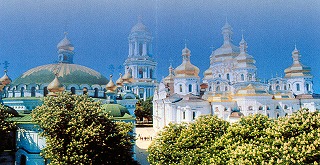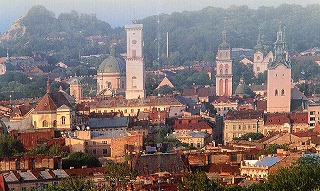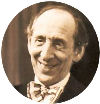|
 |
|
Although the light rain has stopped since dawn, the weather is not clear.
What about the two-day Shin-Urayasu Festival from today? Apparently, it
will be held as planned.
Despite such a worry, the venue of Shin-Urayasu Festival in front of Shoppers'
Plaza is much crowded at noon.
In the afternoon, the "Ukrainian Ambassador's Lecture" was held
in Civic Plaza so successfully that more than a dozen auxiliary seats had
to be added.
The following is a reportage of the lecture.
|
|
| Date & Time: |
|
Saturday, September 12, 2009
1:30-3:30 p.m. |
|
|
|
| Place: |
|
Civic Plaza, Wave 101 Middle Hall |
|
|
|
| Lecturer: |
|
Mr. Mikola Klinichi (Ambassador of Ukraine to Japan) |
|
|
|
| Sponsor: |
|
Urayasu International Friendship Association
(UIFA) |
|
|
 |
|
 |
|
| Ambassador Mikola Klinichi's lecture begins, projecting the slides onto
the screen. |
|
|
| * |
| Origin of the Flag of Ukraine
The flag, a symbol of "independence," was established as the
national flag.
"Blue" symbolizes the sky and "yellow" symbolizes wheat,
representing fruitful agriculture.
|
 |
|
|
|
| * |
Geography, Population, Religion, Education |
|
|
|
Ukraine is located in the south-central part of Eastern Europe, surrounded by 10 countries and the sea.
Russia, Belarus, Moldova, Romania, Hungary, Slovakia, Poland, Turkey, Bulgaria,
Georgia, and Black Sea.
|
|
|
|
 |
|
|
|
The country is divided into 24 regions, similar to the prefectures of Japan.
It is an autonomous republic, with Kiev as its capital. Sevastopol is known
as a large naval base. |
|
|
|
Ukraine covers an area of 600,000 square kilometers, which is the largest
in Europe. It is about 1.6 times the size of Japan, wider than France.
Second to Russia, if it's included.
Our population of 47 million is the fifth largest in Europe and the 21st
in the world. It is inhabited by people from 30 countries. With the history
over thousands of years, as a multinational country, we have understood
each other's traditions and religions.
There are 55 religions living together. Orthodoxy is the largest.
The level of education is high, ranking fourth in the world. |
|
|
| * |
Climate |
|
|
|
95 percent of the country is grasslands and forests. Its 56 percent is fertile black soil, accounting for a quarter of the world.
A few mountains dot the western part and the south of the Crimean region. |
|
|
|
The climate is temperate. We have frost and snowfall at times, but the
cold of winter is not severe.
Summer is hot and dry. Sometimes there are showers and thunderstorms. |
|
|
|
Black soil contains enough moisture in spring and autumn, and absorbs sunshine to the fullest in summer.
In such an environment, Ukraine is traditionally an agricultural country.
It produces wheat, corn, barley, grains, green vegetables, melons, berries,
etc. We export sugar. |
|
|
| * |
History |
|
|
|
Ukraine has had humans since the Stone Age.
During the Copper Age, the oldest Tripila civilization in Europe was born
here with a town, where people lived in wooden houses and did farming.
The Slavonic tribe, the ancestors of the Ukrainians, began living in Ukraine around 1000 BC. |
|
|
|
The city of Kiev is now the political, religious and cultural center of
the East Slavonic people.
Ukrainians, Russians and Belarusians settled in the 5th and 6th centuries,
and later the 12 small principalities got together to form the Kingdom
of Kiev.
In the 10th century it conquered the Byzantine Kingdom and subjugated it
to Kiev, and in the 11th century Kiev became the largest city in Europe.
In the 12th century at its zenith, the three daughters of the King of Kiev
married the kings of France, Norway and Hungary. |
|
|
|
Due to Mongol's invasion in 1240, Kiev was reduced to ashes, and decades
later it was conquered by the Polish–Lithuanian Kingdom.
In the 16th and 17th centuries, the army rose up to make Kiev the political, cultural and religious center again. This army consisted of peasant soldiers, defectors from the Polish–Lithuanian Kingdom, and was the source of later Cossack soldiers. |
|
|
|
During the 17th and 18th centuries, the Ukrainian Cossack states rose and fell repeatedly, and then came under the rule of the Russian Empire. |
|
|
|
In 1710 the first constitution in Europe was drafted here.
Based on democratic norms, it was divided into the executive, the legislature
and the judicature. In addition, the General Parliament and the Cossack
Parliament were established.
With the departure of Russia defeated by Sweden in 1721, Ukraine was divided into several districts until the 19th century. |
|
|
|
After World War I, it declared its independence, but it did not come to
fruition. Then the Red Army won the Russian Civil War, making it a constituent
country within the Soviet Union.
However, with the collapse of the Soviet Union in 1991, a coup d'état occurred.
It was one step towards the independence of Ukraine.
And in the referendum on December 1 that year, 90 percent of Ukrainians called for independence and won. |
|
|
|
Leonid Lovecheck was elected as President, and Congress declared independence,
becoming the world's third nuclear-weapon state. With regard to nuclear
weapons, I would like to add that we have abandoned our possession of nuclear
weapons on the occasion of independence.
In 1996, a new constitution was promulgated, adopting a new currency "Hryvnia". |
|
|
| * |
The Great Famine |
|
|
|
I'd like to talk about the Great Famine, known by the name "Gorodmo".
"Gorodmo" was a great famine from the summer of 1932 to the spring of 1933, and it is said that millions died. |
|
|
|
However, the number of deaths is not accurate, with 5 million, 7 million,
and according to some accounts, more than 10 million. Either way, it's
a massive death. No one thinks it was purely a natural disaster.
For reference, Denmark has a population of 5.2 million, Austria 8 million, Bulgaria 8.5 million, Belgium 10 million, and Hungary 13 million. |
|
|
| * |
Economy and Industry |
|
|
|
The composition of GDP is as shown in the slide (omitted). It is an annual
growth rate of 6-7%. It is supported by fertile land, a highly skilled
workforce, an education system and an industrial base. |
|
|
|
Mineral resources are particularly abundant. Oil has been depleted, but there are coal, hydro and nuclear fuel resources.
The steel industry is also thriving. Ukraine is the world's eighth largest
steel producing country of a wide range of steel products, iron pipes,
etc.
In the chemical and petrochemical industries, coke, inorganic fertilizers, soda, etc. are produced. |
|
|
|
Industrial products include metallurgical products, diesel locomotives,
tractors and automobiles. I'd also would like to mention high-tech electronics,
weapons, and space technology.
We also produce a lot of grain, sugar, meat and dairy products. |
|
|
|
It is also important as a supply route for gas from Russia to Europe. Electricity is also abundant, supplying to Eastern Europe. Recently, atomic power generation has also been developing. |
|
|
|
In space development technology we are the fifth largest in the world,
and a member of the space development nations. Exports of new goods and
technologies are also increasing year by year. |
|
|
|
Ukraine is also a country of aircraft industry.
The AN-124S can carry 150 tons of cargo including locomotives, yachts and
aviation equipment, and 88 passengers.
The AN-225 is the largest strategic aircraft in the world.
The weight of the BURAN machine is 640 tons, the largest weight in the
world. |
|
|
| * |
Foreign Policy |
|
|
|
Ukraine had been involved in the establishment of the UN for more than
50 years. It is among the 51 countries that participated in the drafting
of the United Nations Charter in 1945.
In diplomacy, we are currently seeking close ties with the EU.
In 2005, the EU-UKRAINE ACTION PLAN was launched in Paris, and the Declaration of Partnership was signed on September 9, 2008.
In May of this year, a joint statement on the integration of Eastern Europe was made at the Prague Summit. Ukraine's accession to the EU will be realized in the near future. |
|
|
|
As for security issues, joining NATO (North Atlantic Treaty Organization) is the biggest challenge for our Ukraine.
Although we do not yet belong to NATO, we are actively participating in
European security issues and the movement to get rid of any terrorism. |
|
|
|
The second reason we want to join NATO is for the geography. Ukraine is
a dense transport route to and from Europe.
The third is the relationship in aviation technology, missile industry,
shipbuilding industry and arms industry. |
|
|
|
The fourth reason is the issue of maintaining an advanced army of 250,000
servicemen.
If we join NATO, we will join the collective armaments and defense, which
we expect to lead not only to a reduction in the size of our armed forces
but also economic benefits.
Finally, joining NATO leads to a democratic state. Ukraine's inclusion in NATO will not be far off. |
|
|
| * |
Tourism |
|
|
|
There are many tourist attractions in our country that are not known to
your Japanese people.
Kiev alone has a lot of tourism and cultural heritages as the oldest city
in Eastern Europe. See St. Sophia Cathedral, built in the 11th century
with a 40-square-metre gold mosaic, and the Kivo Pecherska Labra Monastery
during the Lus Kingdom. |
|
|
|
 |
|
|
|
The city of Luviv in western Ukraine is famous for its 13th-century churches,
buildings and artifacts. Two great fires in 1527 and 1556 destroyed the
Gothic structures, but the Renaissance buildings remain. There are also
World Heritage Sites. |
|
|
|
 |
|
|
|
The Kapatian mountain range is a beautiful landscape. There is a ski resort
here. Sports such as mountain climbing and river rafting are popular.
The Crimean region in southern Ukraine has the remains of a Greek city
dating from the 5th century BC along the Black Sea.
The town of Crimea Tater offers medieval culture with the ruins of Harlem. |
|
|
|
Foros and Yalta are also cities worth visiting. Yalta was a holiday home of the Russian king, and the site of the "Yalta Conference" in 1944. |
|
|
|
As I showed you in the slide, when you travel to Ukraine, you can taste
France, Italy, England, Switzerland, ... and various European experiences
in one country. Isn't it economical for travelers? |
|
|
| * |
These Are Ukrainians |
|
|
|
Don't you know Igor Sikorsky, the creator of a helicopter?
He founded Sikorsky Airlines in Kiev. Its airplanes are used by the Self-Defense
Forces in Japan. |
|
|
|
There are six Nobel Prize winners.
Ilya Ilich Meknikov (medicine) in 1908, Abraham Waxman (physiology) in 1952, Shmiel Agon (literature) in 1966, Shimon Kutznetz (economics) in 1971, Ronald Hoffman (chemistry) in 1981 and George Chapak (physics) in 1992.
|
|
|
|
 Nikolai Gogol, widely known as a novelist and playwright in the 19th century,
is a Ukrainian. You may have read either of "Dikanica Near Nights,"
"Mirgorod," "The Prosecutor," "The Cloak,"
"The Dead Soul"... Nikolai Gogol, widely known as a novelist and playwright in the 19th century,
is a Ukrainian. You may have read either of "Dikanica Near Nights,"
"Mirgorod," "The Prosecutor," "The Cloak,"
"The Dead Soul"... |
|
|
|
 The pianist Vladijr Horowitz was born in Ukraine. The pianist Vladijr Horowitz was born in Ukraine.
From the Romantics such as Chopin and Liszt to the classics such as Mozart and Beethoven..., what is your favorite performance?
He played in Japan twice. |
|
|
|
The blind poet Vasil Yaroshenko is also a writer, musician and philosopher.
He spent six years in Japan. He also published a Japanese book. |
|
|
|
There are also many famous athletes such as Selley Bubka in the pole vault,
brothers Krishko in boxing and Shevchenko in soccer.
You may know that Taiho's father is of Ukrainian descent. I meet with Master
Taiho (大鵬親方) from time to time. |
|
|
|
 |
|
|
| * |
Railway Situation (Q&A 1) |
|
|
|
Our railway track standards are different from those in Europe, so travelers
have to change their rolling stock each time, which is inconvenient. I
would like to inform you that there is a movement to change our system
to European standards.
On the other hand, if you come to Kiev via Korea, China or Russia, you can travel long distances by the same train. Time and cost issues aside. |
|
|
| * |
About Japan from My Eyes (Q&A 2) |
|
|
|
Japan is all I like, and in particular, maple trees are fine. The colorful contrast of green, yellow and red is a natural landscape not seen in Ukraine. I enjoy it every year at Mt. Takao.
There is nothing I dislike in Japan, but if anything, it would be a traffic
jam. On the way to Narita Airport, I was once locked in a car for more
than 40 minutes at the Rainbow Bridge. |
|
|
|
|
|
| Prior to the lecture, Mr. Mikola Klinichi had a pleasant conversation with
Mr. Hideki Matsuzaki, Mayor of Urayasu City, who greeted him at Il Mare. |
|
 |
|
 |
|
 |
|
| Photos and wording: Shigeru Koshiba |
|
| Reading (First Half): 12' 35" |
| Reading (Latter Half): 14' 01" |
|
Translated into English
October 7, 2022 |
|
|
|

